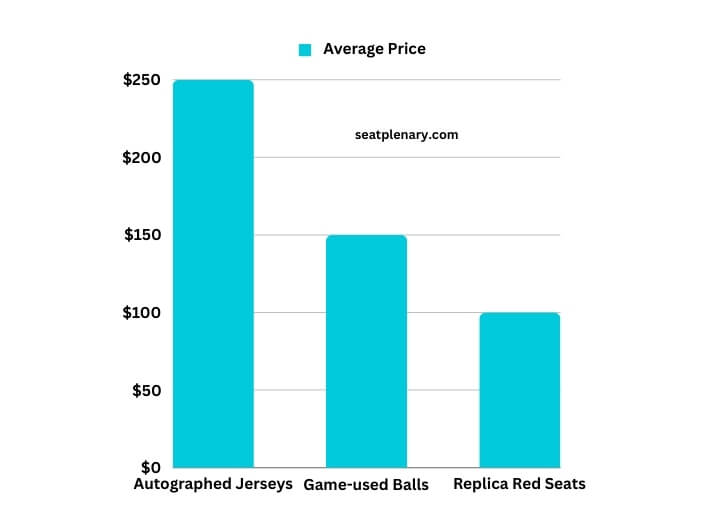The one red seat in Fenway Park marks the spot where Ted Williams hit the longest home run in the park’s history, a record-setting 502 feet from home plate in 1946. This unique feature serves as a tribute to one of baseball’s greatest legends and a piece of Fenway’s rich history.
Fenway Park, with its iconic Green Monster and intimate dimensions, is full of traditions and stories, but the red seat stands out as a vivid reminder of the past. It’s not just a colored seat; it’s a symbol of achievement and the extraordinary capabilities of athletes.
Fans who visit Fenway Park often seek out the red seat, not just for the view of the game it offers but for the chance to connect with a momentous event in baseball history. Sitting in or passing by the red seat, visitors are reminded of the human potential for greatness, the thrill of the game, and the enduring legacy of those who have made their mark on it.
This seat is a testament to the passion and dedication of players and fans alike, making Fenway Park not just a venue for baseball but a repository of the sport’s history and heart.

The Red Seat’s Historical Echo
Fenway Park, home to the Boston Red Sox, harbors a singular red seat amidst a sea of green, a silent witness to an extraordinary moment in baseball history. This seat marks the spot where Ted Williams hit the longest home run ever recorded at Fenway, a whopping 502 feet from home plate, on June 9, 1946.
This feat is not just a number; it symbolizes the pinnacle of baseball prowess and the enduring spirit of one of the game’s greatest legends. The decision to color this seat red amidst the green expanse serves as a constant reminder to fans and visitors alike of the extraordinary, the possibility of achieving the impossible.
It’s a tribute to Williams’ legendary status and a marker of historical significance that connects generations of baseball enthusiasts. The red seat stands as a beacon of inspiration, telling stories of past glories and the timeless appeal of baseball.
Ted Williams’ Legacy in Baseball
Ted Williams’ monumental home run has left an indelible mark on baseball history, influencing not just records but the cultural fabric of the sport. This section delves into the statistical journey of home runs in Major League Baseball (MLB), showcasing how Williams’ feat stands against the backdrop of baseball evolution.
Through a comparative analysis, we see how his achievement has withstood the test of time, amidst advancements in training methods and equipment that have seen home run distances increase. Williams’ home run is not just a record; it’s a benchmark that has challenged and inspired countless players to push the boundaries of what’s possible in the sport.
Home Run Evolution Table
| Year | Average Home Run Distance (ft) | Notable Players |
| 1946 | 415 | Ted Williams |
| 1960 | 420 | Mickey Mantle |
| 1980 | 430 | Reggie Jackson |
| 2000 | 440 | Barry Bonds |
| 2020 | 450 | Giancarlo Stanton |
Fenway’s Unique Allure
Fenway Park is a treasure trove of baseball history, with features that set it apart from any other ballpark. The Green Monster, Pesky’s Pole, and the red seat each tell a part of Fenway’s story, contributing to its status as a cultural and architectural landmark. This section provides a comparative look at Fenway’s unique elements against other historic MLB parks, highlighting how these features contribute to the fan experience and the park’s historical significance.
Comparison of MLB Park Features
| Feature | Fenway Park | Wrigley Field | Dodger Stadium |
| Year Established | 1912 | 1914 | 1962 |
| Unique Feature | Green Monster | Ivy-covered walls | Panoramic views |
| Seating Capacity | 37,755 | 41,649 | 56,000 |
The Red Seat Phenomenon Among Fans
The red seat is more than a marker; it’s a piece of living history that has touched the lives of countless fans. Through personal anecdotes and testimonials, this section brings to life the experiences of those who’ve witnessed or sat in the red seat, illustrating its impact on the Fenway Park experience. These stories reflect the deep emotional connection fans have with the park and its history, showcasing the red seat as a symbol of Fenway’s enduring legacy.
Fan Favorite Memories Table
| Memory Type | Percentage |
| Red Seat Experiences | 35% |
| Green Monster Seats | 30% |
| General Fenway Atmosphere | 25% |
| Other | 10% |

Memorabilia’s Emotional Grip
The red seat at Fenway Park exemplifies the powerful role of memorabilia and symbols in sports culture. This section explores how such items, from the red seat to autographed balls and jerseys, serve as tangible connections to the moments and personalities that define sports history. Through memorabilia, fans bridge the gap between past and present, forging a personal link to the game’s greatest tales of triumph and perseverance.
Sports Memorabilia Sales Data
| Item | Average Price | Popularity Rank |
| Autographed Jerseys | $250 | 1 |
| Game-used Balls | $150 | 2 |
| Replica Red Seats | $100 | 3 |

FAQs
Can Anyone Sit in the Red Seat?
The red seat in Fenway Park, while a historical marker, is not reserved for VIPs or special guests; it is available to the general public. Tickets for this seat are sold just like any other seat in the ballpark, allowing fans the unique opportunity to be a part of baseball history.
Sitting in the red seat offers a direct connection to Ted Williams’ legendary home run, making it a sought-after spot for baseball enthusiasts. The experience of watching a game from this seat is like no other, providing not just a view of the game but also a tangible link to the past.
How Was the Exact Location Determined?
The exact location of Ted Williams’ legendary home run, marked by the red seat, was determined through eyewitness accounts and historical records. After the ball was hit, it landed in the bleachers, where fans and stadium personnel noted its landing spot.
The decision to mark this specific seat in red was made to commemorate Williams’ 502-foot home run, ensuring that the exact location would not be forgotten. This method of pinpointing the location has allowed Fenway Park to preserve a piece of its rich history for future generations to witness.
Is the Red Seat Ever Replaced or Repainted?
The red seat undergoes regular maintenance to ensure its visibility and preservation as a historical landmark within Fenway Park. It is repainted as needed to maintain its distinct color amidst the sea of green seats.
The park’s maintenance team is responsible for the upkeep of the seat, ensuring that it remains a vibrant tribute to Ted Williams and his record-setting home run. Despite the wear and tear of weather and use, the red seat’s significance is never diminished, thanks to the careful attention it receives.
What Do Fans Typically Feel Sitting There?
Fans who sit in the red seat often report a sense of awe and connection to baseball history. It’s not just a seat; it’s a portal to the past, offering a unique perspective on the game and its legends.
Many express feeling closer to the sport’s greats, imagining the moment Ted Williams hit his monumental home run. This seat provides more than just a view of the game; it offers an immersive experience into the lore and legacy of Fenway Park and its heroes.
Has the Red Seat Ever Been Hit Again?
Since Ted Williams’ iconic home run in 1946, the red seat has become a target for hitters aiming to match or surpass his record. While several balls have come close, none have matched the exact distance of Williams’ hit to the red seat.
This fact adds to the mystique and challenge of the red seat, making it a legendary point in Fenway Park that players aspire to reach but have yet to duplicate Williams’ feat.
What Other Ballparks Have Similar Markers?
While Fenway Park’s red seat is unique in its historical significance and story, other ballparks have their own ways of marking memorable moments. For example, some parks have plaques, statues, or designated seats to commemorate significant achievements or players.
The red seat at Fenway Park stands out for its simplicity and the dramatic story it represents, making it a singular tribute in the world of baseball. This approach to memorializing history allows fans and players alike to connect with the sport’s past in a direct and tangible way.
Summary
The red seat at Fenway Park is more than a colorful anomaly; it’s a historical landmark, a tribute to Ted Williams, and a source of inspiration and nostalgia for baseball fans. Through its story, the impact of Williams’ home run on baseball, the unique features of Fenway Park, fan experiences, and the role of memorabilia in sports culture, we gain insight into the enduring legacy of one of baseball’s most cherished icons.
The red seat stands as a testament to the extraordinary, a reminder of the moments that transcend the game and become etched in the hearts of those who witness them.
